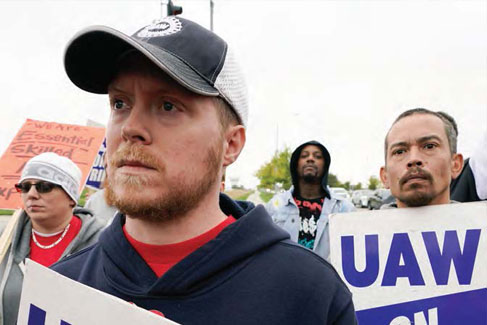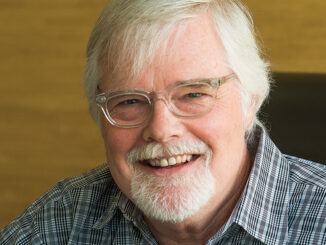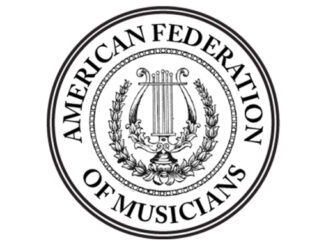
By Rob Callahan
A ghost, or even multiple ghosts, many of my coworkers maintain, haunt the Hollywood headquarters of the Editors Guild.
The building is a mid-century modern affair, boxy steel and glass fronted by a colonnade of spindly palms and bathed in relentless Southern California sunshine. There’s no whiff of the gothic about it, and it’s unlikely that any location scouts would select it as the setting for stories spooky. But over the years, colleagues have on occasion half glimpsed the fleeting shadow of a dim figure lurking on the periphery of their vision, or else heard the fall of Foley footsteps issuing whence there could be no walker, or else felt a momentary chilling draught that couldn’t be blamed on the building’s buggy HVAC. At least half a dozen or so tales of such mysterious encounters circulate regularly among my coworkers.
I don’t have any such ghost stories of my own, and you can color me skeptical.
But even though I fancy myself a sober rationalist, I will confess that the now long-empty office has acquired a certain air of eeriness by virtue of vacancy. It sits on Sunset silently, uncrewed and undisturbed, preserving as if arrested in amber every incidental detail of that moment two years ago when it was abruptly abandoned. In its disuse, the building is evocative of a ghost ship — desolate, adrift, and spookily anachronistic.
Or perhaps the structure calls to mind not a ghost ship, but Norma Desmond’s lonely mansion in “Sunset Boulevard,” aptly described in William Holden’s voiceover as “stricken with a kind of creeping paralysis, out of beat with the rest of the world, crumbling apart in slow motion.” The out-of-beat wall calendar hung next to my desk remains stubbornly stuck on March 2020. It is as though the office itself were obstinately, dissociatively insisting that the past two years have been but an unpleasant dream.
The order to temporarily shutter the Guild offices in the interest of emergency social distancing came down on St. Patrick’s Day, 2020. It was initially intended as a 10-day measure. The reports out of Italy at the time were harrowing, and closures and shutdowns were already starting to result in the layoffs of IATSE members nationwide; we knew things were taking a bad turn. But it was hard to imagine then, with the virus still only newly dominating the news, that these unusual exigencies might prove enduring.
Thus began, for Guild staff as well as for much of our membership, a regime of remote work that would last for years rather than for weeks.
By the time this column sees print, Editors Guild employees will likely have returned to work in our L.A. and New York offices in at least a hybrid way, the pandemic permitting. This homecoming will entail some blowing off dust and some clearing of cobwebs. And I’ll need, of course, a new calendar.
But the recrewing of our ghost ship also affords an occasion to reflect on what these past two odd and anxious years have wrought — for our organization, for our parent union, and for the labor movement more generally. Any haunting is the story of a place that sits uneasily in its time, laden with a history unreconciled with the present. Spookiness results from our dim but well-founded suspicion that our ever-ephemeral present is always vanishing ere we’ve managed to apprehend it, and the narrative function of a ghost’s sleepwalk is to bid the living to wake more fully to the truths of our pasts and our possible futures.
What, then, ought we now make of how these two strange years have changed us, and where we go from here?
“There are decades when nothing happens,” V. I. Lenin is said to have observed, “and weeks when decades happen.” (There’s some question over the authenticity of the epigram, but, whether or not Lenin actually said it, he ought to have.) These past two years have at times felt like entire decades full of nothing happening as we locked ourselves down in claustrophobic sequestration, hunkering in our bunkers while the virus went about its grim work and much of ordinary human enterprise was held in abeyance. And at other times — sometimes, in fact, at the very same times — these pandemic days felt as eventful as entire tumultuous decades, with long-held norms unceremoniously discarded and convulsions of historical magnitude shaking us to our cores. One paradox of this pandemic is the question of whether it’s a period in which nothing happened or one in which everything happened.
Within the arena of the U.S. labor movement, the pandemic years and recent months, especially, have exhibited a frenzy of activity, perhaps even resembling a renaissance. Gallup’s polling shows public support for labor unions in the U.S. has climbed higher than it has been in more than half a century. The pandemic’s disruptions have obviously inspired many to rethink their relationship to work, and a great many workers have clearly found that relationship wanting. By some counts, new union organizing campaigns now are double their numbers from just a year ago. Headlines have heralded high-profile unionization drives at large or noteworthy employers such as Amazon, the New York Times, and Starbucks. And the news has abounded with stories of organized workers taking increasingly militant stands, including large and consequential strikes at such employers as Columbia University, Kellogg’s, and John Deere. Organized labor, all this buzz would suggest, is in the midst of a long-awaited comeback.
And yet some key figures don’t support this sanguine narrative. Actual union density — the percentage of the workforce represented by organized labor — continues its decades-long decline. Recently released numbers from the Bureau of Labor Statistics show that U.S. private sector union membership shrank in 2021 to 6.1% of the workforce, the lowest proportion since the agency began tracking this statistic. For all the apparent activity and shift in sentiment, labor’s clout seems still to dwindle.
At the level of public policy, the story is similarly one suspended between the poles of promise and paralysis. The Biden administration came into office vowing to be unprecedently pro-union, and it has, indeed, followed through. Biden immediately went about instituting a change of regime at the National Labor Relations Board, and the newly pro-worker NLRB looks to make significant rule changes to give employees more clout in their struggles with management. For the first time in nearly a half century, a former union leader serves as the head of the Department of Labor. Biden himself has used the bully pulpit to champion organizing efforts. Moreover, this February the White House Task Force on Worker Organizing and Empowerment issued a report detailing more than five dozen proposed policy changes intended to promote collective bargaining.
But the Task Force’s recommendations, even if fully implemented, would probably only have at most a marginal effect on the trajectory of organized labor. Some shifts in stance at the NLRB will likely prove more consequential, but even those would represent only modest gains for workers seeking to wield power on the job. More dramatic changes to labor law — such as the proposed PRO (Protect the Right to Organize) Act or the elements of the PRO Act that were incorporated into the Build Back Better Bill — look to be irretrievably stuck in the divided Senate. The flurry of federal activity notwithstanding, prospects remain dim for fundamental change in the legal terrain for workers hoping to exercise their collective bargaining rights.
If ambivalence vexes the perspective at the macro level — a slew of indications signaling new vitality in the labor movement even as hard data and legislative inaction augur a continuation of our slow, inertial slide into irrelevancy — so, too, is a close-up view of our very own union perturbed by paradox.
Unlike organized labor as a whole, our local has definitely not been shrinking. To the contrary, as of the time of this writing our local has approximately 8,900 members, an increase of close to 6% since the start of the pandemic. Some small portion of that growth might be attributed, directly or indirectly, to the impact of organizing, but most of it is likely due to the boom times our industry currently enjoys.
The strength of our union, though, is not a function of numbers alone. Last fall we wowed everybody, not least of all ourselves, by delivering an overwhelming vote to authorize a work stoppage in an industrywide strike authorization election unprecedented for the IATSE. (It is not true — as the press widely misreported — that the IATSE has never gone on strike, but IATSE strikes, which are frequent, target specific employers rather than an entire industry.) Had the strike taken place last year, it would have been the largest private-sector strike in the U.S. since 2007. On the strength of our formidable strike threat, union negotiators were able to secure contractual gains that objectively outpaced those in any IATSE agreement in recent memory.
Our union can’t return to business as usual. We understand our power now.
But those achievements notwithstanding, the contract fell significantly short of many members’ expectations, let alone desires. Its accomplishments were incremental advances, and not revolutionary transformations of what work looks like in our industry. Only weeks after a strike authorization in which IATSE members displayed near unanimity, the ratification vote revealed a membership deeply divided. In a vertiginous turn of events, over the course of just forty-two days, we demonstrated our union was both more strongly united and more profoundly fractured than anyone might have predicted.
If my calendar stuck upon March 2020 testifies to a terrible lacuna, to all that we’ve lost and all that has been utterly transformed over these two years, its testimony doesn’t render any clear verdict on what we might make of this anomalous age. For those of us committed to worker empowerment, have the ghosts of these pandemic-pilfered years led us to the beginning of the best of times, or merely a continuation of the worst of times?
If what we might make of our recent past or our present remains muddled in ambiguity, perhaps our sense of what to aim for in our future can be clearer. Because, although the staff of the Guild might be returning to work in Guild offices, it’s clear that our union must not return to business as usual. We have a better appreciation now of the power we are capable of exercising, and we understand better how vital is the work of perfecting our union — making it more inclusive, more democratic, more participatory — to ensure that power is exercised effectively. Hence our initiatives underway to revamp the Guild’s steward structure and to more actively engage rank-and-file members in steering the course of the organization.
There is much we can and must do over the course of the next two years to take the unprecedented union spirit on display last fall and channel it into making our union stronger for the long term. Our venture to the brink last fall has engaged the attention of many members who had previously been indifferent to Guild affairs; sustaining such engagement will be critical to enforcing contractual rights won and winning more down the line.
In early February I attended, alongside some of our IATSE kin and allies from throughout the L.A. labor movement, a rally for members of Bakery Workers (BCT-GM) Local 37. The workers were on strike against Jon Donaire Desserts, a company in southeast L.A. County that manufactures ice-cream cakes sold by Baskin Robbins and other retailers. They were fighting for modest increases to their pay, for less abusive mandatory overtime, and to beat back an employer proposal to dramatically increase their healthcare costs. The strike was then entering its fourth month, an agonizingly long slog for low-wage workers going without a paycheck.
One of the object lessons of the Bakery Workers’ fight, of course, was the necessity of advance preparation: even highly profitable corporations will go to unusual lengths to resist their employees’ call for a larger slice of the pie (or, in this instance, ice-cream cake), and it’s critical that workers seeking change build reserves and formulate strategies to allow them to weather a protracted standoff.
Planning for the future, of course, is critical, but so, too, is attending to the demands of the present. The workers were buoyed by a call-and-response chant of “Un día más!” answered by “Un día más fuerte!” It was a reminder that endurance, and also recovery, can depend on our complete commitment to the moment before us and to those kin with whom we share it. A fight of months’ duration can only be won a day at a time, lasting one day longer and growing each day stronger.
As we take tentative steps towards whatever normalcy might look like in the future, we must carry forward the losses and lessons learned over the course of two trying years, with an eye towards readying ourselves for future victories and a commitment to taking on our present struggles day by day.
Let’s push aside the ghosts and hang that new calendar.






